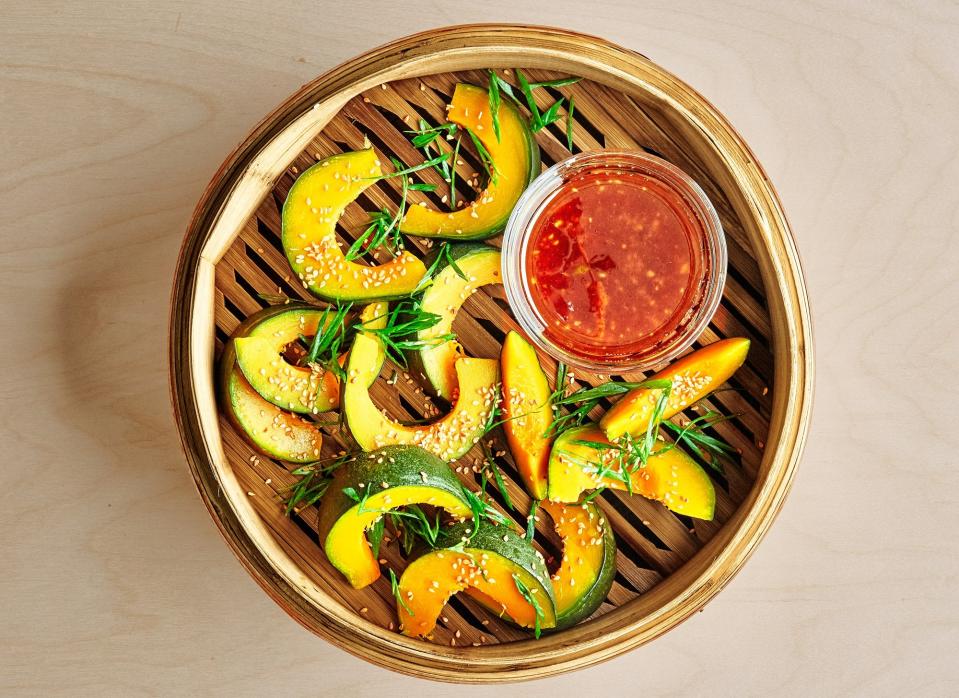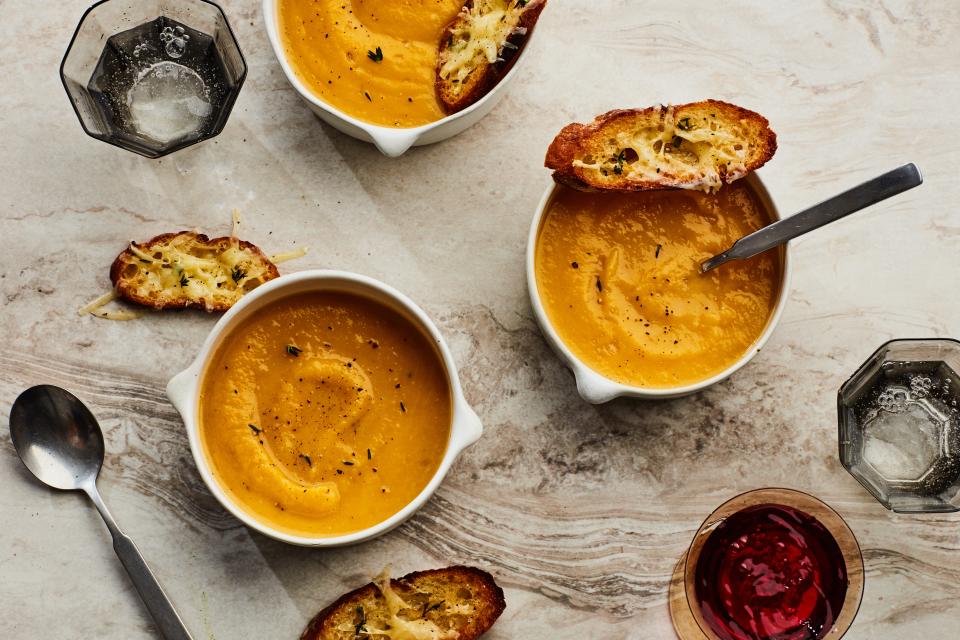How to Cook Butternut Squash in the Oven or on the Stove and Win at Fall
How did butternut squash become the most-cooked squash in America? I don’t know and I do not have the evidence to back up that last statement. What I do know is that you probably bought one, but it’s sitting around while you figure out what’s next. And I believe that knowing how to cook butternut squash is essential kitchen intelligence, particularly during the cooler autumn and winter months.
You can cook butternut squash in a variety of ways with great results: roasting, steaming, grilling, sautéing. More good news: As far as winter squash varieties go, butternut is pretty easy to dissect (get the full rundown on how to cut butternut squash here, and some short GIF tutorials here). Furthermore, I never peel butternut squash. Sure, you can do it if you want, but I find that peeling squash makes it slippery and more difficult to handle. Plus, the skin is totally edible and will blend if you’re blending it, and taste great if you’re not.
Not ready to tackle slicing and dicing squash with your own chef’s knife? Precut butternut squash is fine too: catch both Epi’s David Tamarkin and Andrew Spena in their grocer’s checkout line justifying their love for market-prepped produce.
But you’re here to find out how to cook butternut squash, so let’s get on with that:
How to roast whole butternut squash
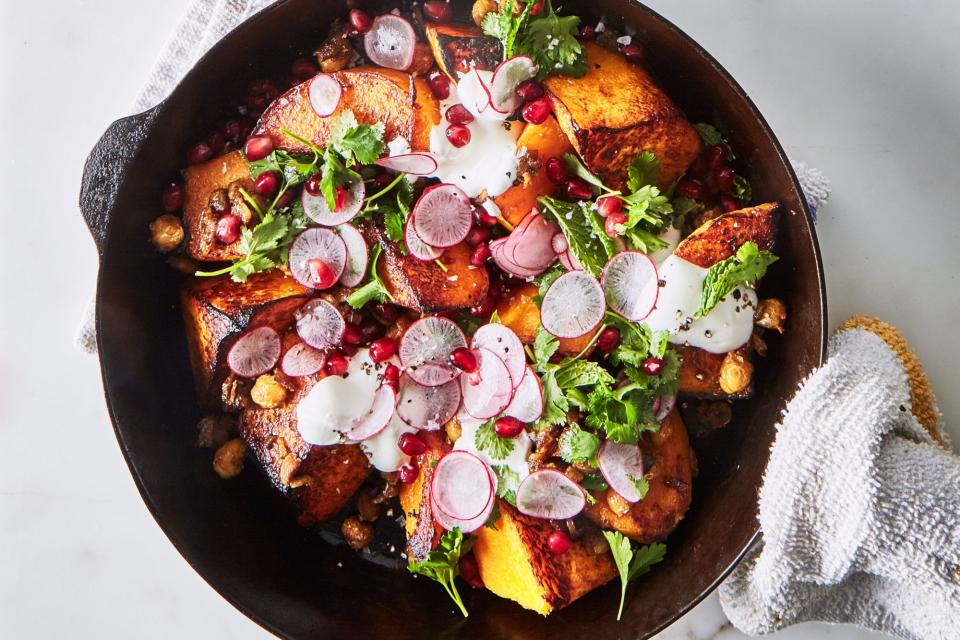
One-Skillet Roasted Butternut Squash with Spiced Chickpeas
Photo by Alex LauIf you’re at home with a whole squash but don’t care to tackle cutting through the hard flesh yourself, don’t. Roast the squash whole (at 425°F for 45 to 60 minutes, depending on size, until you can easily pierce through the center of the long end with a paring knife), and then cut it (or even tear it with your bare hands once it’s cooled down a little).
Roasting butternut squash whole does have a few disadvantages. It takes a little longer, you’ll have to wait until it’s cool enough to handle to scoop out the seeds, and you won’t get much caramelization on the flesh, which is really what makes roasted squash taste so good. To remedy that, sear the torn or cut pieces in a pan, like Claire Saffitz does in the recipe below, and then top the cooked squash with crumbled cheese, green sauce, crispy beans, other roasted or pickled vegetables, or anything else that sounds good to you.
One-Skillet Roasted Butternut Squash with Spiced Chickpeas
Bon Appétit
Roasted Butternut Squash with Herb Oil and Goat Cheese
Bon Appétit
How to roast butternut squash halves

Hasselback Butternut Squash With Bay Leaves
Photo by Bobbi LinMy personal favorite way to cook butternut squash is to cut the bulbous end away from the long end, then split the two pieces in half through the root/stem ends. Scoop out and discard the seeds, then oil and salt each piece. Roast these four pieces, cut side down, in an oven set to 400°F for about 40 to 60 minutes: again, until a paring knife (or even better, a cake tester) slides easily in and out of the long end. The benefits are, in my opinion, minimal prep for maximum reward: The flesh in contact with the roasting pan will caramelize, concentrating the squash’s natural sugars, which really is the point of roasting as a cooking method.
You don’t need to split the two ends apart, though. If you’d like to roast intact halves as in this Rhoda Boone recipe, you can turn butternut squash into a holiday-worthy centerpiece inspired by twice-baked potatoes. Ditto this recipe by Anne Redding and Matt Danzer, wherein the squash is partially roasted in halves and then sliced in the style of a Hasselback potato and roasted again while basting to finish cooking.
Twice-Baked Butternut Squash With Parmesan Cream and Candied Bacon
Hasselback Butternut Squash with Bay Leaves
Bon Appétit
How to roast diced or sliced butternut squash
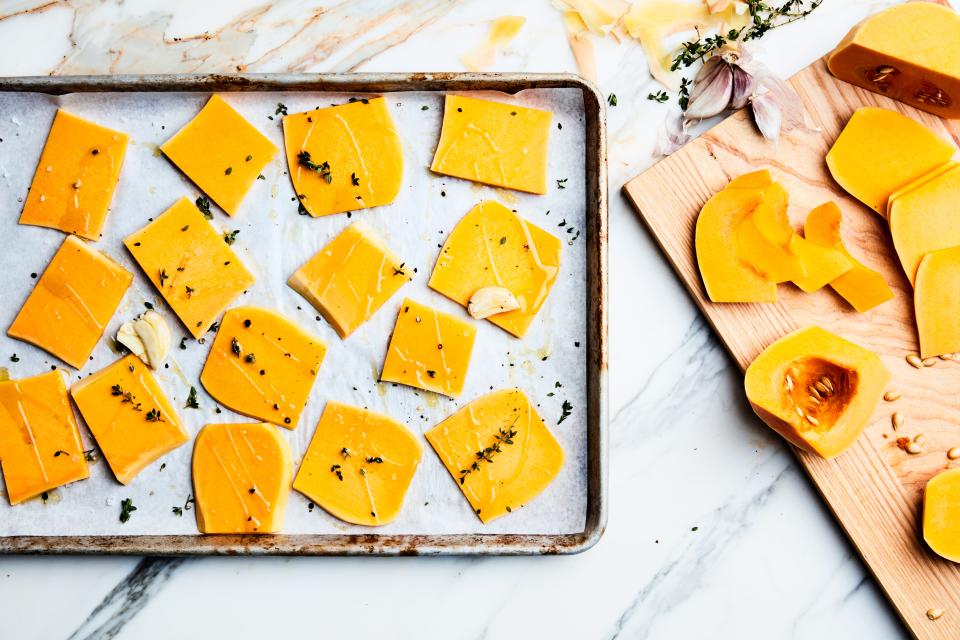
Butternut Squash Sandwich Cheddar Cheese and Pickled Red Onion INSET
Just cut the butternut squash into planks or cubes, toss with oil, salt, and whatever spices you like, and then roast at 450°F for 20 to 30 minutes. Some might argue that this is the absolute best way to cook butternut squash; you’ll get the ultimate caramelization because you have more of that flesh exposed. The downside: a bit more work in prepping the squash.
Pork Tenderloin with Turmeric, Squash, and Collard Greens Salad
Butternut Squash Sandwich with Cheddar Cheese and Pickled Red Onion
How to cook butternut squash in a pan
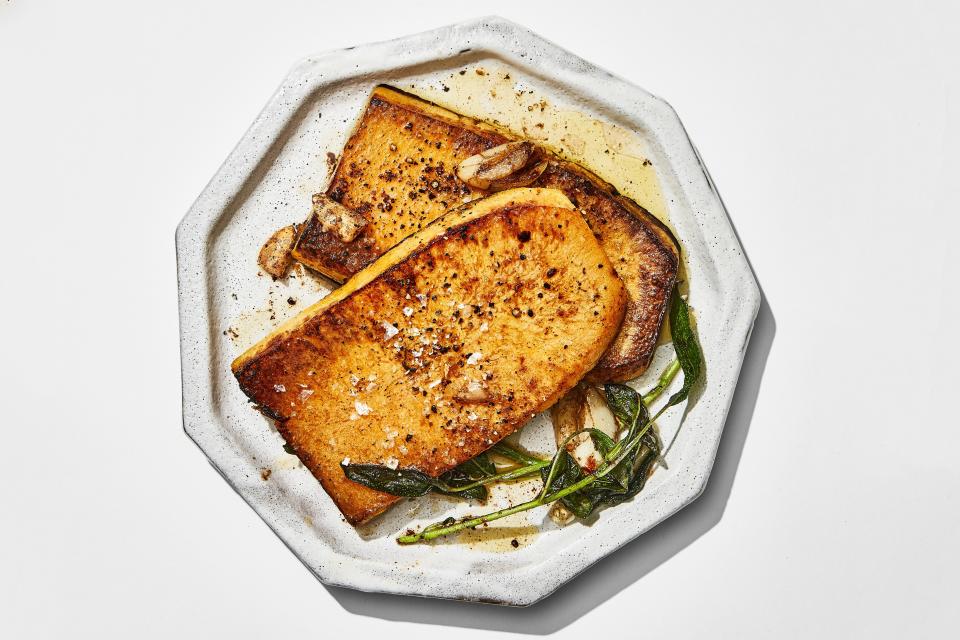
Butternut Squash Steaks with Brown Butter–Sage Sauce
Photo by Alex Lau, Food Styling by Sue LiWhen cooking butternut squash in a pan on the stove, you still have options: First, you can cut the long neck of the squash into planks, sear the planks, and baste them with a sage-infused butter, like in this recipe from Anna Stockwell. This method makes for an impressive presentation and a delicious vegetarian main course.
To do it, heat oil in a pan and then slide in the planked squash. Flip the planks every 2 to 3 minutes—this ensures it cooks evenly—until they’ve browned on both sides and they’re tender throughout.
Of course, you can also sauté cubed squash to eat as a simple side dish, add to pasta or a salad, or use in some other way. To do that, add the cubed squash to a pan slicked with oil set over medium-high heat. Use a wooden spoon to toss the squash occasionally until it’s well browned on all sides, about 10 to 12 minutes.
Butternut Squash Steaks with Brown Butter–Sage Sauce
Bon Appétit
Sunflower Seed "Risotto" with Squash and Mushrooms
How to steam butternut squash
To steam butternut squash, dissect the long neck from the bulbous end. Cut the neck in half lengthwise and then slice each half into half-moons about ½-inch thick. Halve the bulbous end, scoop out and discard the seeds, and then slice horizontally into ½-inch-thick strips. Lay the strips in a steamer basket (there can be some overlap, but try for a single layer—or, if you have a stackable steamer, feel free to divide the squash among a few baskets).
Fill a large pot with about 1 inch of water. Bring to a boil, then place the steamer in the pot, making sure the vegetables are not submerged. Cover and steam until the squash is tender, about 12 to 15 minutes. (Use a paring knife or cake tester to check your squash for tenderness.) If you’d like a little more guidance in bringing the dish together, check out the recipe below, which calls for kabocha, but works well with butternut.
Steamed Kabocha With Ginger-Soy Dressing
Bon Appétit
How to cook butternut squash for soup
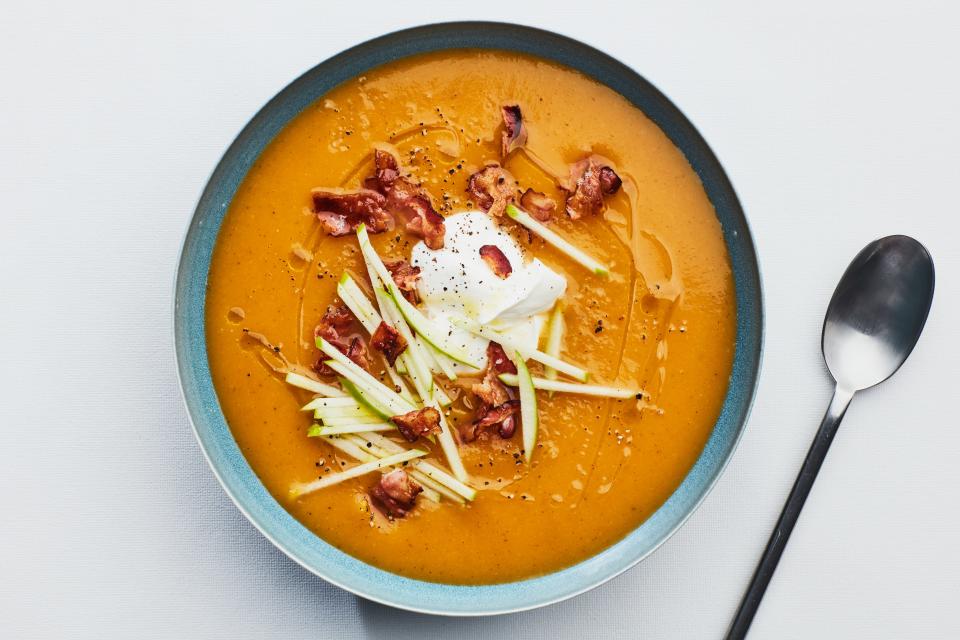
Butternut Squash & Apple Soup
Photo by Chelsea Kyle, Food Styling by Laura RegeHonestly, you could use any of the methods above to cook butternut squash for soup. Toss cooked (or leftover) squash into the blender with sautéed onion and apples, pour in a bit of stock, and blitz to a purée, and you’ve discovered one of the easiest and most satisfying uses for fall leftovers I know of.
Want a soup with whole, unpuréed squash bits? Cut the raw squash into even cubes and then toss them into your simmering broth, knowing they’ll be ready to eat about in 11 minutes.
Miso-Tahini Squash Soup with Brown Rice
Winter Squash Soup with Gruyère Croutons
Bon Appétit
Butternut Squash and Apple Soup
Gourmet
How to bake butternut squash into a gratin
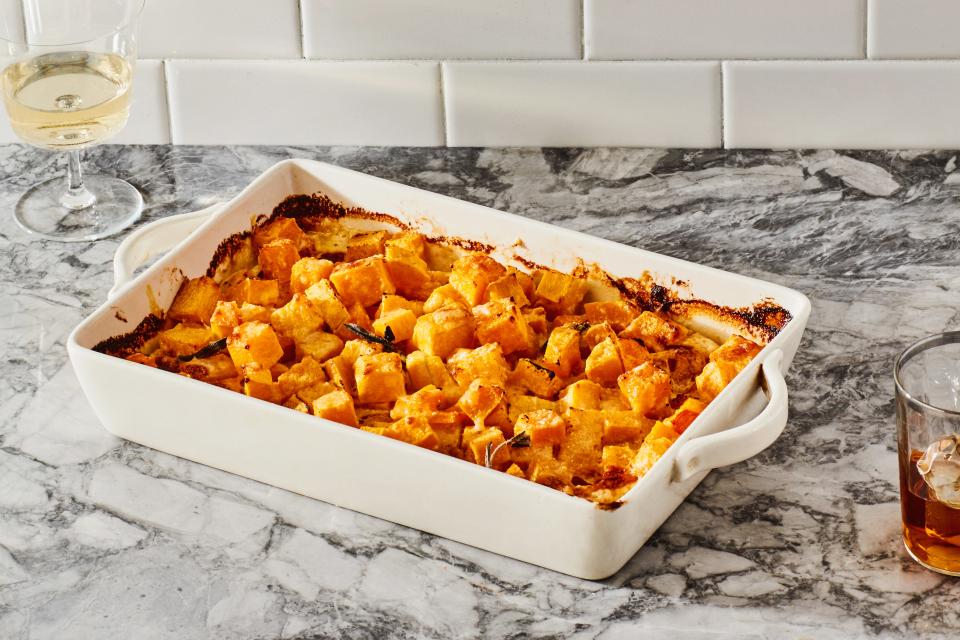
Parmesan Roasted Butternut Squash
Photo by Chelsea Kyle, Prop Styling by Beatrice Chastka, Food Styling by Olivia Mack AndersonThis dish is fancy enough for the holiday table but easy enough to pull off on any weeknight. Cube squash (or cut it into thin planks) and toss with a bit of cream and salt. Spread in an even layer in a casserole dish. Bake, tightly covered, for about 30 minutes at 400°F. Add some cheese and continue to bake uncovered until the squash is tender and the cheese is bubbling and browned.
Butternut Squash and Creamed-Spinach Gratin
Gourmet
Parmesan-Roasted Butternut Squash
Gourmet
Want more of our favorite butternut squash recipes? Here you go.
Originally Appeared on Epicurious





